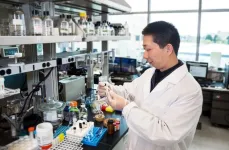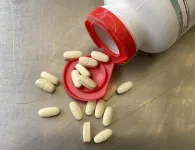(Press-News.org) Insulin production has, for the last 50 or so years, come with some risks to the patient. Even so, the medication is lifesaving for the estimated 537 million adults living with diabetes worldwide, with that number expected to grow.
Recent clinical studies show that injection via insulin pens can cause insulin to reach the bloodstream so quickly that hypoglycemia, or blood sugar levels that dip below the healthy range, may result. Automated insulin pumps can deliver precise insulin and minimize this risk but are expensive and available only to a small portion of diabetes patients around the world.
Now, a plant-based, oral delivery of proinsulin could address these drawbacks, according to a new study published in the journal Biomaterials, led by Henry Daniell of Penn’s School of Dental Medicine.
Although clinical insulin has been in use for several decades, it is missing one of the three peptides that occur in natural insulin. The Daniell lab created a plant-based insulin that contains all three peptides and can be ingested orally. The strength of plant cell walls protects insulin from acids and enzymes in a patient’s stomach before the material is broken down by gut microbes. Then, the released insulin is delivered to the liver via the gut-liver axis.
Using diabetic mice, Daniell and his team found that their plant-based insulin regulated blood sugar within 15 minutes of ingestion very similarly to naturally secreted insulin. In comparison, mice treated with traditional insulin injections experienced rapidly decreased blood glucose levels leading to transient hypoglycemia.
“The risk of hypoglycemia is one of the biggest disadvantages of the current delivery system and can even result in a coma. Our insulin, given orally, has all three proteins and is delivered right to the liver. It works just like natural insulin, which minimizes the risk of hypoglycemia,” Daniell says.
Daniell has long researched uses for plant-grown proteins. In a study published in 2015, he led a team of researchers who, for the first time, demonstrated the commercial viability of producing a low-cost drug made from lettuce plants. In that paper, researchers used freeze-dried lettuce leaves to produce an effective drug for hemophilia patients. Daniell has also worked on plant-based medicines to treat pulmonary arterial hypertension, Alzheimer’s disease, polio, and dental plaque and created a plant-based gum that reduces the viral load of COVID-19 in saliva.
To produce plant-based insulin, scientists identified human insulin genes and then used what Daniell calls a “gene gun” to blast the genes through the tough plant cell walls. The insulin genes are then integrated into the plant’s genome, in this case the lettuce genome. The resulting seeds permanently retained insulin genes, and subsequently grown lettuce was freeze dried, ground, and prepared for oral delivery following FDA regulatory guidelines.
This process is vastly different from producing insulin in the traditional manner, which involves growing the hormone in bacteria or yeast cells, an expensive process requiring purification and a low temperature for transportation and storage. Daniell’s production method eliminates the need for expensive, complex laboratory equipment and results in a product that is shelf stable at room temperature.
Daniell says, “We’ve seen news stories about vaccine doses being destroyed because some countries don't have the resources for cold storage throughout the process. It is an enormous cost. This kind of post-production cost is eliminated using our methods because we have shown repeatedly that the product is shelf-stable.”
Going forward, Daniell plans to test plant-based insulin in canine and human subjects.
“A lot of dogs have diabetes, and the owners have to be home to give insulin three times a day,” he says. “We’ve done canine studies in the past in dogs with hemophilia or heart disease, and we know how to mix the plant powder in their food and add some bacon flavor. They love it.”
For people, plant-based delivery of medicines could dramatically alter treatment for diabetes and other diseases.
“With this delivery system, we change the whole paradigm, not only for insulin,” Daniell says. “I grew up in a developing country and saw people die because they couldn’t afford drugs or vaccines. For me, affordability and global access to health care are the foundation for my work. And in this case we are making insulin more affordable while significantly improving it. Patients can get a superior drug at a lower cost.”
Henry Daniell is vice chair and the W. D. Miller Professor in the Department of Basic and Translational Sciences in the University of Pennsylvania School of Dental Medicine.
Daniell’s coauthors on this paper were Rahul Singh, postdoctoral fellow; Venkata Mangu, senior postdoctoral fellow; Smruti Nair, doctoral candidate in dental medicine; Geetanjali Wakade, postdoctoral fellow; and Nataliya Balashova, research assistant professor at Penn Dental.
Daniell is a patentee in this field. Relevant information on patents and applications is available online.
This study was supported by the National Institutes of Health, United States (Grant R01 HL 107904) and a Commonwealth of Pennsylvania, Department of Community and Economic Development grant.
END
A plant-based, oral delivery of insulin regulates blood sugar levels similar to natural insulin
A new, affordable method of insulin delivery developed by Henry Daniell of the School of Dental Medicine lowers the risk of hypoglycemia when compared to current diabetes treatments.
2023-06-15
ELSE PRESS RELEASES FROM THIS DATE:
Nursing homes serving Black residents have greater hospitalizations, emergency department visits
2023-06-15
Staffing levels likely drive the differences in hospitalizations and emergency department visits among nursing homes, the researchers report in the Journal of the American Geriatrics Society.
Studies show that nursing homes serving high proportions of Black residents may experience poor healthcare outcomes. To better understand the environmental and structural characteristics of nursing homes that may lead to these outcomes, the researchers examined data from 14,121 U.S. nursing homes using multiple ...
When materials discovery glitters
2023-06-14
By Rebekah Orton
Thomas Edison famously tried hundreds of materials and failed thousands of times before discovering that carbonized cotton thread burned long and bright in an incandescent light bulb. Experiments are often time consuming (Edison’s team spent 14 months) and expensive (the winning combination cost about $850,000 in today’s money).
Expenses and time increase exponentially when developing the quantum materials that will revolutionize modern electronics and computing.
To make quantum material discovery possible, researchers turn to detailed databases as their virtual laboratory. A new database of understudied quantum materials ...
Just add sugar: Research shows common antioxidant can be more beneficial through glycosylation
2023-06-14
New research shows that polyphenolic compounds, which are commonly found in fruits and vegetables, can be combined with sugar molecules to create potential life-saving drugs.
Polyphenols are a class of compounds found in many plant-based foods. Polyphenols help prevent cellular damage in the body and can help to prevent diseases such as cancer or heart disease. However, many of them do not dissolve in water, making it difficult to fully take advantage of their health benefits.
Biological Engineering Professor Jixun Zhan and his graduate students Jie Ren and Caleb Barton recently published a comprehensive ...
Dietary supplementation shown to improve nutrition biomarkers in study of older men
2023-06-14
CORVALLIS, Ore. – A six-month study of healthy older men demonstrated that daily multivitamin/multimineral supplementation had a positive effect on key nutrition biomarkers.
The research led by Oregon State University’s Tory Hagen and Alexander Michels also showed that the changes in nutrition status could have direct connections to cellular function, measured by the oxygen consumption of the study participants’ blood cells.
The findings, published in the journal Nutrients, suggest that supplementation may be a key tool to help people stay healthier as they age.
“Many older adults take ...
Remains at Crenshaw site are local, ancestors of Caddo, study finds
2023-06-14
Hundreds of human skulls and mandibles recovered from the Crenshaw site in southwest Arkansas are the remains of ancestors of the Caddo Nation and not foreign enemies, according to a new study published in the Journal of Archaeological Science.
Collaborating with the Caddo Nation in Oklahoma, researchers at the University of Arkansas and Arkansas Archeological Survey tested lead and strontium isotopes in the teeth of human remains and compared them to ancient animal teeth from several surrounding regions to determine that the 700-year-old human remains were local ...
The Viking disease can be due to gene variants inherited from Neanderthals
2023-06-14
Many men in northern Europe over the age of 60 suffer from the so-called Viking disease, which means that the fingers lock in a bent position. Now researchers at Karolinska Institutet, together with colleagues, have used data from over 7,000 affected individuals to look for genetic risk factors for the disease. The findings, which have been published in Molecular Biology and Evolution, show that three of the strongest risk factors are inherited from Neanderthals.
Up to 30 percent of men in northern Europe over 60 suffer from ...
Further hope for base-edited T-cell therapy to treat resistant leukaemia
2023-06-14
Three young patients with relapsed T-cell leukaemia have now been treated with base-edited T-cells, as part of a ‘bench-to-bedside’ collaboration between UCL and Great Ormond Street Hospital for Children (GOSH).
The data from the NHS clinical trial, published in The New England Journal of Medicine and funded by the MRC, shows how donor CAR T cells were engineered using cutting edge gene editing technology to change single letters of their DNA code so they could fight leukaemia.
The experience of using the cells in three patients is shared, and includes 13-year-old Alyssa from Leicester, who last year was the first person in the world to ...
A new way to visualize force-sensing neurons
2023-06-14
A recent study by researchers at Texas Children’s Hospital, Baylor College of Medicine, and Scripps Research Institute has discovered fluorescent dye FM 1-43 as an effective and versatile tool to visualize PIEZO2 ion channel activity in mechanosensory neurons. The study, published in Neuron, was led by Dr. Kara Marshall, assistant professor at Baylor College of Medicine and investigator at the Jan and Dan Duncan Neurological Research Institute at Texas Children’s Hospital, with Dr. Ardem Patapoutian, Nobel Laureate and professor at Scripps Research Institute.
Mechanosensation is the ability ...
Study finds that proven medications for alcohol use disorder are rarely given to adolescents and young adults on public insurance
2023-06-14
BOSTON – Heavy drinking commonly begins in adolescence and is a known risk factor for the development of alcohol use disorder (AUD). Data from adult clinical trials suggest offering evidence-based medications for AUD to younger adults could promote their engagement in treatment and improve clinical outcomes.
But are those medications being used when and where they are needed? In a review of claims data for youths insured by Medicated in 15 U.S. states, a team of researchers found that most youths with a diagnosis of AUD do not receive medications as part of their therapy, despite ...
Phosphate, a key building block of life, found on Saturn’s moon Enceladus
2023-06-14
An international team including a University of Washington scientist has found that the water on one of Saturn’s moons harbors phosphates, a key building block of life. The team led by the Freie Universität Berlin used data from NASA’s Cassini space mission to detect phosphates in particles ejected from the ice-covered global ocean of Saturn’s moon Enceladus.
Phosphorus, in the form of phosphates, is vital for all life on Earth. It forms the backbone of DNA and is part of cell membranes and bones. The new study, published June 14 in ...
LAST 30 PRESS RELEASES:
Heart-brain connection: international study reveals the role of the vagus nerve in keeping the heart young
Researchers identify Rb1 as a predictive biomarker for a new therapeutic strategy in some breast cancers
Survey reveals ethical gaps slowing AI adoption in pediatric surgery
Stimulant ADHD medications work differently than thought
AI overestimates how smart people are, according to HSE economists
HSE researchers create genome-wide map of quadruplexes
Scientists boost cell "powerhouses" to burn more calories
Automatic label checking: The missing step in making reliable medical AI
Low daily alcohol intake linked to 50% heightened mouth cancer risk in India
American Meteorological Society announces Rick Spinrad as 2026 President-Elect
Biomass-based carbon capture spotlighted in newly released global climate webinar recording
Illuminating invisible nano pollutants: advanced bioimaging tracks the full journey of emerging nanoscale contaminants in living systems
How does age affect recovery from spinal cord injury?
Novel AI tool offers prognosis for patients with head and neck cancer
Fathers’ microplastic exposure tied to their children’s metabolic problems
Research validates laboratory model for studying high-grade serous ovarian cancer
SIR 2026 delivers transformative breakthroughs in minimally invasive medicine to improve patient care
Stem Cell Reports most downloaded papers of 2025 highlight the breadth and impact of stem cell research
Oxford-led study estimates NHS spends around 3% of its primary and secondary care budget on the health impacts of heat and cold in England
A researcher’s long quest leads to a smart composite breakthrough
Urban wild bees act as “microbial sensors” of city health.
New study finds where you live affects recovery after a hip fracture
Forecasting the impact of fully automated vehicle adoption on US road traffic injuries
Alcohol-related hospitalizations from 2016 to 2022
Semaglutide and hospitalizations in patients with obesity and established cardiovascular disease
Researchers ‘listen in’ to embryo-mother interactions during implantation using a culture system replicating the womb lining
How changing your diet could help save the world
How to make AI truly scalable and reliable for real-time traffic assignment?
Beyond fragmented markets: A new framework for efficient and stable ride-pooling
Can shape priors make road perception more reliable for autonomous driving?
[Press-News.org] A plant-based, oral delivery of insulin regulates blood sugar levels similar to natural insulinA new, affordable method of insulin delivery developed by Henry Daniell of the School of Dental Medicine lowers the risk of hypoglycemia when compared to current diabetes treatments.







